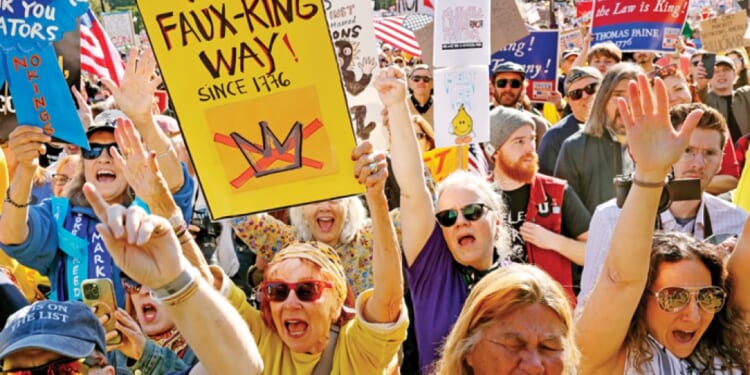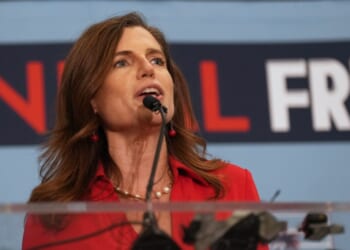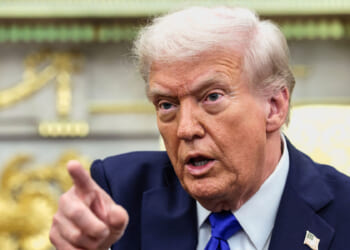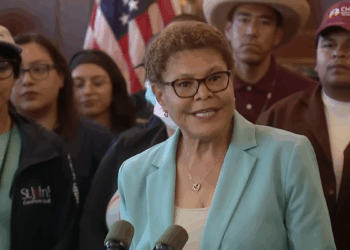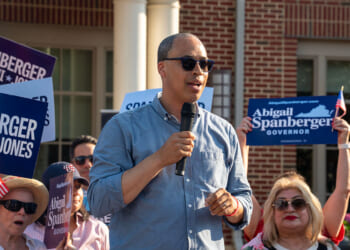“The Wrong ICE is Melting,” read one sign hoisted in the air by a white woman in a COVID-19 mask on the streets of Los Angeles. “Don’t Let Democracy Go Extinct,” read a poster held in Omaha, Nebraska, by a very serious liberal in an inflatable dinosaur costume. “Free Palestine, Free DC, Free Us All,” read a banner waved during a march down the National Mall in Washington.
Millions of people took to the streets to protest something in mid-October. What that was, exactly, was less clear. Billed as “No Kings” protests against an American monarchy that does not exist, the demonstrations took aim at a host of things that also do not exist in America: fascism, military occupations, and a vast conspiracy to cover up an Epstein-Trump sex ring.
Just this month, violent protests erupted at the University of California, Berkeley, during a Turning Point USA event. Federal investigators are looking into whether university and police officials failed to protect attendees.

The protests encapsulated a broader problem facing Democrats, more than one year after President Donald Trump’s entirely predictable victory nonetheless shocked them. The party has nothing but fictional villains to sell to its mostly affluent base, and no direction in which to guide the bottomless resources of the elites in its pocket.
But 60 years after anti-Vietnam War protests swept the nation, many people who came of age romanticizing the righteous energy of those protests now have second homes in the country and time on their hands to reenact the glory days. And that makes them useful for the web of left-wing groups that have instructions from the billionaires who fund them to pursue radical societal change.
“The hard Left has a much more ambitious agenda than the suburban white woman who holds a No Kings sign out on the street corner,” Peter Flaherty, chairman and chief executive officer of the National Legal and Policy Center, told the Washington Examiner. “It’s really a struggle for control of what’s left of the Democratic Party.”
What’s left tends to be older, whiter, and more highly educated than the multiracial coalitions of Democrats past. Free from the concerns of the working-class voters whom they hope to rescue from the clutches of misinformation and bigotry, these affluent boomers have the privilege of worrying more about the injustice of it all than the fact that a decade’s worth of savings can no longer get a 30-something couple close to a down payment on a first home. They have democracy itself to save, anyway.
How exactly is democracy under attack, one might ask? In January, it was because Trump pardoned Jan. 6, 2021, rioters. In March, it was because super-wealthy Ivy League universities stopped getting taxpayer money. In October, it was the beginning of construction on Trump’s privately financed renovation of the White House’s East Wing.

For the groups that fuel the Left’s protest culture, the problem is that people are simply not yet angry enough about these things, and the solution is to amplify as many of them as possible in the hopes that one may spark outrage they can use for more sinister ends.
They have plenty of money and institutional support to try. No Kings was backed by a sophisticated network of liberal nonprofit organizations, led by a powerful group called Indivisible, that together have vacuumed up hundreds of millions of dollars to advance the progressive project. What that is at the moment is unclear. Whether it was ever anything more than a collection of niche left-wing grievances that were briefly astroturfed into the mainstream by dark money is also, presently, unclear.
Follow the money
Indivisible started as a 23-page Google document, drafted by married former congressional staffers Leah Greenberg and Ezra Levin in 2017, that sought to instruct prospective activists how to disrupt town halls and ribbon-cutting ceremonies to pressure members of Congress. Levin said at the time that his goal was “copying the Tea Party strategies and tactics (minus the racism and violence).”
The guidelines went viral, and a progressive organizing powerhouse was born. Left-wing billionaire George Soros gave it $350,000 that year via a grant through the Tides Foundation, a massive “social justice” grantmaker that acts as a pass-through for liberal dark money, and subsequently provided it with an additional $6.7 million through 2023, according to Soros’s philanthropy, the Open Society Foundations.
The original guide explicitly instructed activists to avoid forming an agenda and instead focus all their energy and resources on stalling Trump’s. The only goal of Indivisible’s work, according to the guide, was to pressure Democrats and centrist Republicans in Congress into blocking as much of Trump’s agenda as possible by creating the illusion of mass resistance to it.
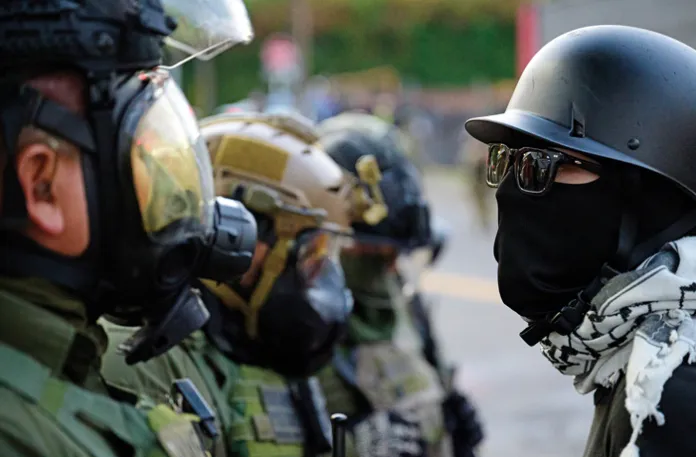
“We strongly recommend focusing on defense against the Trump agenda rather than developing an entire alternative policy agenda,” the guide reads. The authors argued that working on a policy agenda is “quite frankly, a distraction,” because the goal of the entire project was opposition to Trump.
The guidelines laid out detailed instructions for how activists could create “the impression of broad consensus” at congressional town halls, including by coordinating a list of questions and talking points before the event, ensuring that activists don’t sit together to conceal their association with each other, and working to “amplify” each activist by “either booing the Congressman or applauding” after each hostile question is asked.
Eight years later, Indivisible is orchestrating the highest-profile protests against the second Trump administration. The No Kings demonstrations in October, sponsored by 294 “partner” organizations but coordinated primarily by Indivisible, followed a series of protests outside Tesla dealerships to show opposition to Elon Musk’s association with Trump. Indivisible helped coordinate the “Tesla Takedown” protests that targeted Tesla dealerships across the country.
Like No Kings, the Tesla Takedown protests were meant to appear as organic expressions of discontent — and were frequently described that way by the corporate media. But many of the events were organized by Indivisible using a platform called Mobilize, which Democratic campaigns and progressive groups across the Left use to collect people’s information and turn them out to events.

And as Indivisible drew protesters to wave signs and scream about the Department of Government Efficiency outside Tesla dealerships earlier this year, some of those same dealerships became the targets of violent attacks.
In Kansas City, Missouri, a 19-year-old college student was charged by the Justice Department with arson for allegedly firebombing a pair of Cybertrucks on March 11. An Indivisible chapter organized Tesla Takedown events at the same Kansas City Tesla dealership that took place within days. In Las Vegas, a 36-year-old man was charged by the DOJ with arson and unregistered possession of a firearm after he allegedly destroyed five Teslas by hurling Molotov cocktails into them and shooting them up with an AR-style gun. He also allegedly spray-painted “RESIST” across the front of the center on March 18. Days later, protesters gathered outside a nearby Las Vegas Tesla dealership as part of an Indivisible-backed “Global Day of Action” against Tesla and Musk. In Tigard, Oregon, authorities do not appear to have caught the person or people who fired bullets through the windows of a Tesla dealership there on March 6 and March 13, but Indivisible was sponsoring protests outside the same dealership shortly afterward.
“More often than not,” Christopher Rufo of the Manhattan Institute and David Reaboi of the Claremont Institute wrote of Tesla Takedown in the City Journal, “violent and nonviolent tactics reinforce one another and work toward the same ends.”
Deep-pocketed progressive donors, however, maintain clean hands.
“It’s not like George Soros calls up some group and says, ‘I want a riot,’” Scott Walter, president of the Capital Research Center, told the Washington Examiner. “It’s much more complicated and messy than that.”
“But on the other hand, the places that George Soros gives money to do end up being involved in violence over and over again,” Walter added.
Indivisible has denied any connection with the violent attacks on Tesla cars, charging stations, and dealerships — there were dozens of recorded instances this year — and in organizing materials, it encourages activists to engage in peaceful protests at all times.
Walter’s CRC said in a report published this year that Soros’s Open Society Foundations has, since 2016, given more than $23 million to seven groups that “engage in or materially assist violence, property destruction, economic sabotage, harassment, and other criminality that meets the FBI’s definition of domestic terrorism.” Those included groups that train protesters in “direct action” tactics, such as forming blockades, and raise money to bail out and defend violent protesters.
The Open Society Foundations denies giving money to groups that support violence. “The Open Society Foundations opposes all forms of violence, including violent protests, and these accusations — which are drawn from a discredited report — are outrageous and false,” an Open Society Foundations spokesperson told the Washington Examiner. “Our mission is to advance human rights, justice, and democratic principles at home and around the world. All our activities are peaceful and lawful. We stand for fundamental freedoms guaranteed by the Constitution, including the rights to free speech and peaceful protest that are hallmarks of any vibrant democracy.”
Tracing the true source and amount of money behind progressive protest tactics that range from disruptive, such as boycott campaigns and highway banners, to violent, such as militant attacks on Immigration and Customs Enforcement facilities, is difficult. Millions of dollars flow throughout the movement via massive grantmakers, including Tides, the Arabella Network, and the Ford Foundation, that effectively hide the origin of the money.
“Funding networks like the ones run by Tides and Arabella obscure who is funding what,” Walter said. “A billionaire, or a billionaire foundation, can put money into Tides, but we can’t then tell which of Tides’ many grants to outside groups was funded by the billionaire’s grant.”
Some of the most destructive tactics come cheap, too.
“The actual, really ugly stuff does not take that much money,” Walter said. “So if you are a white college kid in grad school for the eighth year, the bank of Mom and Dad can probably handle your black bloc and your mace and whatnot.”
The dark side
The darker side of a movement that casts its opponents as existential threats to the country and its opposition to them as morally righteous doesn’t necessarily advertise its #struggle for #justice on Bluesky or recruit from the same pool of Chardonnay moms for its foot soldiers.
But antifa’s goals overlap in meaningful ways with the goals of larger, reputable protest organizers, and the success of the latter can create a permission structure for the violent activities of the former.
Democrats dismiss the rise in antifa-linked violence by denying that antifa, which has websites, T-shirts, a legal defense fund, training conferences, and an accreditation process for chapters nationwide, is an organization. That’s allowed them to avoid having to answer for antifa violence that targets their enemies and invokes the same hyperbolic rhetoric one might hear any given weeknight on MSNBC.
“The Left likes polarization,” said Flaherty of the National Legal and Policy Center. “The Left benefits by confrontation. If you look at the last round of No Kings protests, it was very revealing, because even though Indivisible is kind of the vanguard, they had a coalition of 200 groups, and in some cities like New York, groups like the Communist Party USA were what they call partners. So Indivisible has no enemies on the Left, and I think it just shows that Marxist-Leninism is part of their DNA in that they actually view violence as a tool that will help them achieve power.”
Antifa militants in Portland, Oregon, have, in the words of White House officials, “laid siege” to an ICE field office for months this year in an effort to stop immigration enforcement. The protests began in June, and they turned especially violent on the day of the first nationwide No Kings protests. As thousands of progressives took to the Portland streets to protest ICE and other Trump-related outrages on June 14, some of the protesters peeled off from the No Kings demonstrations and joined what had become violent clashes at the ICE facility. Some of the activists hurled fireworks at officers and used a stop sign as a makeshift battering ram to shatter a glass door to the office. Photographs of the riot were dotted with No Kings signs.
But Portland police have faced criticism for failing to contain the anti-ICE riots, just a few years after Portland prosecutors were criticized for dropping hundreds of cases related to the 2020 racial justice riots that Portland police also did not contain.
“You had the same kind of crazies in the ‘60s, right? You had violent nihilists who hated America in the ‘60s,” Walter of the Capital Research Center said. “But the reason the Weather Underground had to be underground is that big-city mayors wouldn’t tolerate this in their streets, including Democratic mayors like [Richard] Daley in Chicago.”
“A huge part of our current problem is that most big cities are run by nutty radicals,” Walter added. “The fact that Portland, Seattle, San Francisco, Chicago, that they won’t actually do law enforcement against violence and criminals, that’s a terrible thing, and highly problematic because honestly, I don’t want the feds doing a lot of this. That is more dangerous, in civil liberties terms, and it’s also impractical.”
The objective
Trump’s second-term agenda has ignited a fury within the Democratic base that its leaders seemingly have no idea how to control.
But unlike the Resistance to Trump 1.0, there’s more of that fury to go around. Progressives’ discovery that the cultural victories they won from 2020 to somewhere around the time Theo Von was explaining cocaine highs to Trump on a podcast were not only receding, but may have in fact been a mirage all along, fueled a deep sense of betrayal.
And the Left seemed equally shocked by the speed with which the public collectively agreed the progressive moment was over.
Hollywood, corporations, and media companies responded to the commercial incentives of the vibe shift by abandoning the leftist causes they’d aligned themselves with just a few years earlier. Football players went from kneeling during the national anthem to doing the “Trump dance” in the end zone, and the Left suddenly saw traitors all around.
With Democrats in Congress and governors’ mansions already practicing maximalist politics at the behest of progressives, their Trump 2.0 protests may be aimed as much at the civil institutions they view as having capitulated to Trump as at the Democrats who already couldn’t wait to vote “no” on reopening the government for the 14th time.
And unlike during his first term, when progressive groups successfully pressured Washington and virtually all civil institutions into neutering his presidency, Trump has taken aim squarely at the asymmetric advantages progressives have long enjoyed. Setting his sights on the nongovernmental organization complex, universities, Big Law firms, corporate media outlets, and sprawling federal bureaucracies that have remained firmly in liberal hands regardless of who comes and goes from the White House, Trump has become more than a useful foil for organizing marches. He represents a true threat to the power that the Left has spent decades amassing.
But there is another, darker element to the ideology that keeps middle-aged suburbanites and fresh college graduates screaming into the void together about SpaceX and Epstein files.
“We’ve had a very ideological movement, really starting in middle schools, but certainly starting in high schools and especially in the prosperous suburbs, that has created a kind of protest culture that sees America as fundamentally the source of evil in the world,” Charles Lipson, political science professor emeritus at the University of Chicago, told the Washington Examiner.
Anti-American ideology has, over decades, crept from the radical fringes of academia to the mainstream of the Left, where it has been credentialed by institutions that have lent it outsize legitimacy. The 1619 Project, which began as a series of essays in the New York Times and morphed into an educational curriculum that recasts American history as a shameful product of racism, won the Pulitzer Prize. The Academy Awards began with a land acknowledgement proclaiming that Hollywood is built on land stolen from Native Americans. The New York City Council voted to remove a statue of Thomas Jefferson, the author of the Declaration of Independence, that had stood in City Hall for more than a century, citing his slave ownership.
Students who are increasingly exposed to leftist ideas in their grade school classrooms will find themselves inundated with those sentiments if they attend any elite university, where protests are now part of the social fabric of the college experience. That some of those protests target the universities themselves, often some of the most liberal institutions in the country, as bastions of inequality over long-past historical inequities or obscure investments, offers a preview of how those students will likely view the less liberal society they’ll graduate into.
And for the rising cohort of leftists, the politics of resistance is too important to bother with the politics of anything else.
“I think the coalition on the Left, which has been around on college campuses for probably two decades now, is almost entirely a negative coalition,” Lipson said. “That is, they are held together by what they are against, not anything that they’re for, and that’s not an oversight. The reason for that is the nature of the groups in the coalition have such different goals affirmatively that they really couldn’t say, ‘Well, I’m for a Gaza that really is open to gays and lesbians and transgenders,’ because the Muslims in that coalition would not favor that. Indeed, they’d be quite opposed to that.”
“They just have all of these self-contradictory policies which are held together not because they’re in favor, I think, of some positive agenda, but because they’re against things,” Lipson added. “And what are they mostly against? They’re against capitalism. They’re against the idea that America is a fundamentally good society.”
What brought the various factions of the Left to the conclusion that America must be radically changed certainly differs. Some believe America’s towering achievements could never atone for the sins of its founders and thus must be destroyed as penance. Others see an economy that produces such stark wealth inequality as inherently evil, no matter how high it has lifted the quality of life of even its poorest participants. And still others may appreciate the utility of the system that created the world’s most free and prosperous nation but see it now as a hindrance to their far more enlightened idea of social progress.
Perhaps ironically, the language of the Left, in the Trump era, is nominally preservationist. Saving democracy, protecting norms, and fighting authoritarianism draws plenty of normal people to their friendly neighborhood protests. But the well-funded organizers of those marches interpret those ideas so differently as to render the words meaningless, because the America they’re fighting for does not yet exist and couldn’t possibly under the framework the founders envisioned.
Of course, most of the protesters lining up in Park Slope before brunch probably aren’t concerned with all that.
“We’re not talking about a mobilization of liberals,” Flaherty said. “We’re talking about a broader movement that, when the time comes, will be happy to utilize violence to achieve their goals.”
“What’s going to trigger the next round of violence? I don’t know,” he added. “But I do know that Western economies are long overdue for a crisis. I believe the Left will be ready to capitalize on it. I think they can turn a monetary crisis into a crisis in capitalism and democracy itself, and that’s their goal.”
Sarah Bedford is the Washington Examiner investigations editor.

